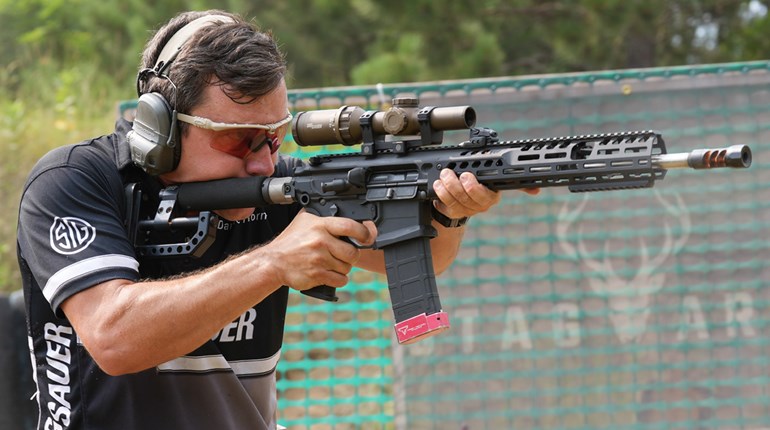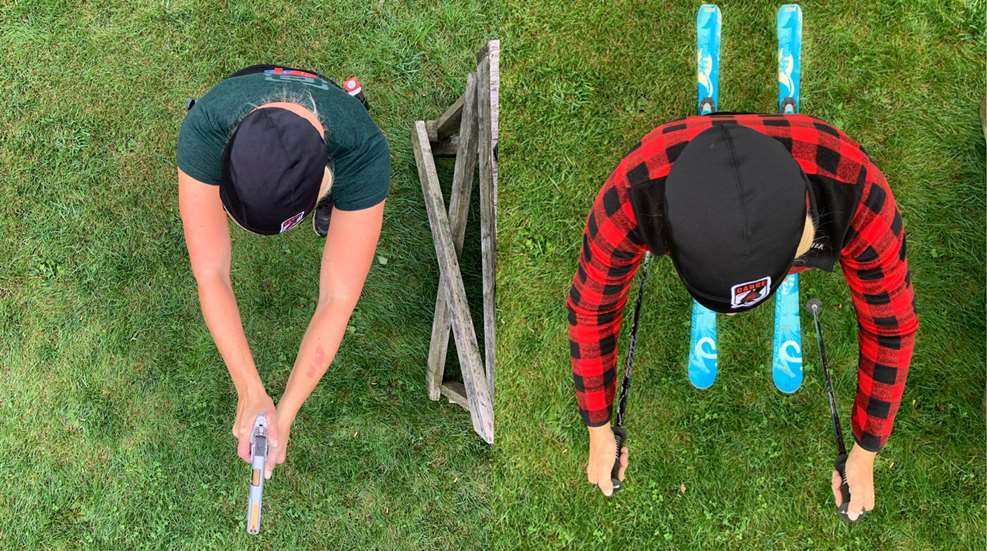
For a person who has never shot competitively before, it can be helpful to relate some basic concepts of how you use your body in other sports. Specifically, sports that require balance and management of weight cross over to shooting pretty well. I used to instruct in alpine skiing and was certified through PSIA (Professional Ski Instructors of America). When I teach a new shooter, I use concepts that I learned in my hundreds of hours becoming PSIA certified to impart the physical aspects of shooting. Skiing and shooting are similar in ways you might not even consider, but I’m going to share a few common concepts that might help the average skier become a better than average shooter.
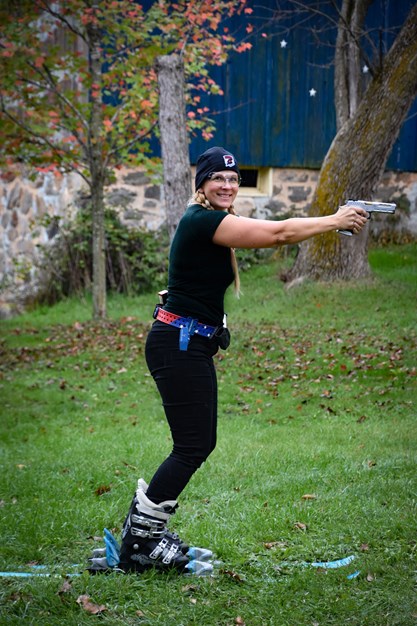 Awareness
Awareness
When skiing, you need to have good awareness of your body: where you are in relation to the terrain and where your skis are under your body. The same is true for shooting. You have to be aware of where your gun is in relation to your body and target.
Balance
Both shooting and skiing require good balance. A great example is initiating a turn in skiing. If you pull back the foot on the side that you want to turn to and at the same time, lighten your weight on that ski, the skis will turn you as a function of their shape. This requires balance from the skier, and it’s definitely something you get the feel for.
Similar to a turn in skiing, when you change direction or leave a position in shooting, you begin to lighten the weight on the foot you are going to move first. Competitive shooters perform this motion when they initiate an exit from a shooting position. It’s very similar to a turn in skiing and highlights how much weight management plays a role in any dynamic sport.
Stability
In both sports, competitors need to maintain a stable platform and separate movement in the upper and lower body. This is another way in which you initiate turns and manage your balance while skiing. An experienced skier will tell you that you can rotate your torso and point your belly button downhill, yet your skis and legs will twist and move under your torso in order to navigate terrain and turns.
Similarly, when you shoot on the move, you will keep the lower body moving in the direction you need to travel, while your upper body rotates like a tank turret. In shooting, keeping your lower body moving and upper body “quiet” helps you move faster and avoid losing time in short stages that require a quick execution.
Direction
Anyone who skis knows that you are going to go in the direction your skis are pointed. This simple concept is the key to navigating steep terrain without getting out of control. If you point your skis across a black diamond hill, you’re not going to go too fast. You’re going to slowly navigate in the direction of your skis. How fast you go is a function of how steep your skis are in relation to the mountain.
When shooting, your feet are indicators of your natural point of aim. Your goal should always be to start with some sort of natural point of aim. This is simply where your body is naturally pointed and where the gun is pointing as a result. You won’t be very accurate if your feet and body are pointed away from the target, causing you to constantly fight your body to aim.
Whether it’s skiing or shooting, what you do with your feet translates to the rest of your body. In skiing, you see it in how well you execute a skill. If you are late to initiate a turn, you might see your skis move into positions you don’t want, causing your turns to be late and you can end up twisted and fighting yourself.
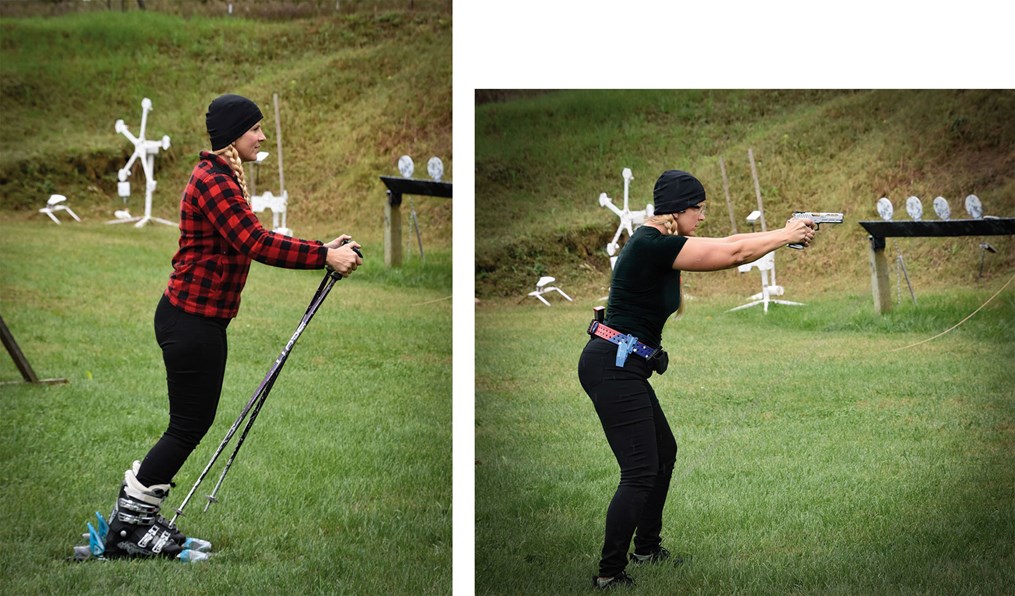
In shooting, you see what’s happening with your feet show up in your sights, especially when you shoot on the move. Generally, shooting on the move requires that your feet do not slap or hit the ground hard, which causes the sights to dip as your feet impact. To keep the sights up and steady, competitive shooters need to move with heel-toe type steps.
Functional Tension
Another way that shooting and skiing are similar is the need to hold your body in specific ways. Holding tension in your body to counter a force that you anticipate is something done both in skiing and shooting.
A great example in skiing is the pressure on your boots, or functional tension in your legs. You know that you want your weight to be on the fronts of your skis … but how do you get it there? Teaching someone to hold tension in their legs to counter the forces that will come is something, in my opinion, best done by trying and feeling. And shooting is very similar!
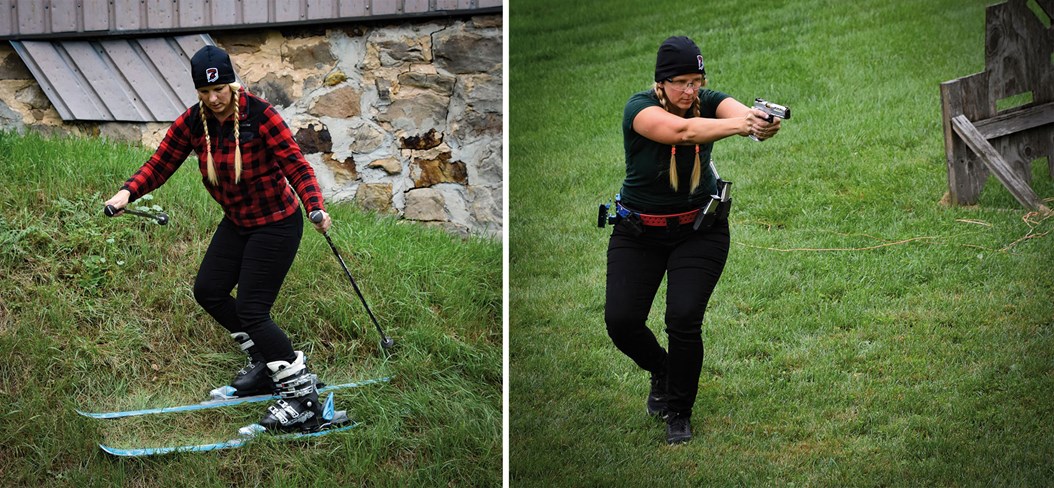
While an instructor can tell you to put your weight on the balls of your feet, drop your strong side foot backward and think about using your toes to "grab" the dirt, it’s a different feeling. Recoil adds another force that you have to learn to manage. How you manage the forces created by recoil is where you develop your skill.
Here’s how I demonstrate how functional tension works for shooters. I ask students to hold their empty pistols as if shooting, while I push up against the dust cover, telling them not to let the gun rise. The tension that they have to hold to keep me from pushing the gun upward is what they need to hold in their arms and shoulders when they shoot. What happens is you hold tension there in anticipation of the forces of recoil; in order to be more efficient, you start counteracting that force before it happens. You do not “relax” like a limp noodle that will be pushed off target by the recoil.
Progression Requires Mastery
How do people shoot fast? They hold tension that helps them manage and recover from recoil faster, so they can see their sights on target sooner, and so they can pull the trigger sooner. Shooting fast isn’t a function of how fast your finger manipulates the trigger. Shooting fast is a function of how fast you do everything else in between pulling the trigger. Having your body READY to do these things will make you even faster. Functional tension in the right places helps us to shoot faster. Whether people call that by other names or not, the way they hold that tension, how much, in what direction ... it all comes into play as you develop your personal skill with a firearm. But you have to know about functional tension to begin with.
\
Mastering any type of shooting requires that you not only have body awareness, but use it to understand, manage, and control what’s happening to your body, and firearm, as you shoot. Applying some athletic principles to the forces acting on your body, as well as the forces you can apply to the firearm, will help you to become a better shooter. The better you understand these concepts, the further you will go!
Most active sports require you to control, balance and move your body with a certain degree of precision. The skills necessary to ski or participate in other dynamic sports translate very well to competitive shooting. If you can ski, you can shoot!















